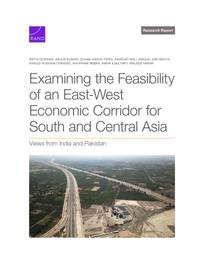Examining the Feasibility of an East-West Economic Corridor for South and Central Asia
Views from India and Pakistan
ResearchPublished Feb 20, 2025
The authors discuss the feasibility of a land-based East-West Economic Corridor (EWEC) connecting Afghanistan, India, Iran, Pakistan, and the Central Asian republics by exploring whether regional and global changes could facilitate an EWEC. The authors analyze results from a questionnaire they sent to policy experts from India and Pakistan. The authors then present recommendations for creating a successful EWEC.
Views from India and Pakistan
ResearchPublished Feb 20, 2025

In this exploratory report, the authors ask whether an East-West Economic Corridor (EWEC) linking Afghanistan, the Central Asian republics (Kazakhstan, Kyrgyzstan, Tajikistan, Turkmenistan, and Uzbekistan), India, Iran, and Pakistan is feasible. Earlier efforts to develop economic corridors in this region have failed. The causes, the authors find, do not lie in doubts about the corridors' economic viability. Instead, the causes appear to be geopolitical alignments, internal conflicts, relations between EWEC members, great-power relations of EWEC members, and barriers to external capital.
The authors reviewed literature about past corridor initiatives and developed a case study of regional pipeline initiatives to identify the causes of past successes and failures. The authors also explored the salience of these and possibly new causes through in-person interviews with policymakers and policy analysts in India and Pakistan.
This research was supported by the Junaid Family Foundation and the RAND Center for Asia Pacific Policy Advisory Board and conducted by RAND International.
This publication is part of the RAND research report series. Research reports present research findings and objective analysis that address the challenges facing the public and private sectors. All RAND research reports undergo rigorous peer review to ensure high standards for research quality and objectivity.
This document and trademark(s) contained herein are protected by law. This representation of RAND intellectual property is provided for noncommercial use only. Unauthorized posting of this publication online is prohibited; linking directly to this product page is encouraged. Permission is required from RAND to reproduce, or reuse in another form, any of its research documents for commercial purposes. For information on reprint and reuse permissions, please visit www.rand.org/pubs/permissions.
RAND is a nonprofit institution that helps improve policy and decisionmaking through research and analysis. RAND's publications do not necessarily reflect the opinions of its research clients and sponsors.